Just transferred to the keg today. Pretty easy to do. First I emptied and sanitized the secondary collector, hooked it up again, and cycled the valve to make sure there wasn't gunk stuck in the ball valve. Then I sanitized the tube and fittings, hook it up, and open the valve.
Next time I might just use the sampling valve to transfer, since it will be sitting above any gunk. Opening and closing the main valve with the empty secondary collector disturbs the beer because of the air bubble, so it might have stirred some gunk back into the beer. Either way I'm pretty happy, other than the leaking lid. I might just put an extremely think bead of silicone around the top to act as a gasket.
Opening the empty collection port would also introduce a fair bit of oxygen. If your the kind of cat that worries about that sort of thing...





